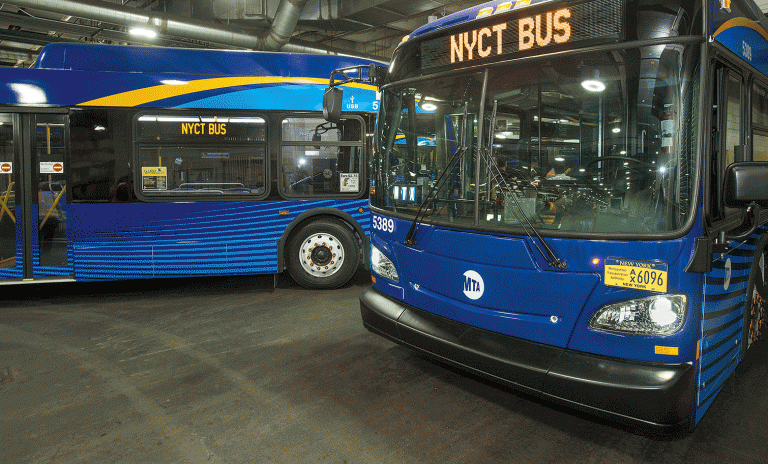Photo Courtesy of MTA/Patrick Cashin
According to the administration, NYC has 2.5-times more bus riders than any other city in the country—but also the nation’s slowest buses, with a current average speed of 8 miles an hour.
By Michael V. Cusenza
Mayor Bill de Blasio on Monday announced the formation of an advisory group for his Better Buses Action Plan.
Launched in April, Hizzoner’s big bus project aims to increase bus speeds by 25 percent across the five boroughs by the end of 2020. According to de Blasio, City agencies, the Metropolitan Transportation Authority, elected officials, transit advocates, and others represented in the Better Buses Advisory Group will share thoughts about how to improve service along critical corridors around NYC.
Of the 15 elected officials appointed to the BBAG, five represent borough communities, including: City Councilmen I. Daneek Miller (D-St. Albans) and Donovan Richards (D-Laurelton); State Sens. Leroy Comrie (D-St. Albans) and James Sanders, Jr. (D-South Ozone Park); and Assemblywoman Nily Rozic (D-Flushing).
“As someone who has used mass transit for most of my life, I know how important reliable bus service can be and I support making it more efficient,” Sanders said. “I am proud to be a part of the Better Buses Advisory Group. We hope to create an easier ride for the millions of people who travel daily by bus to work, school, doctor’s appointments and more.”
As part of the Better Buses Bus Action Plan, the City Department of Transportation has identified 20 projects to improve travel times, including parts of Southeast Queens, and along traffic-choked Fresh Pond Road in Ridgewood and Rockaway Beach Boulevard between Beach 116th and Beach 73rd streets.
Miller characterized the BBAP as “a long-awaited document, setting forth guiding principles to help bring relief to communities across the city. According to GPS data, transportation deserts such as Southeast Queens have seen some of the most significant declines in bus travel speeds since 2015, and our reality on the ground supports this analysis. Bus riders in Southeast Queens are only able to connect to other buses and subways through the commercial hub of Downtown Jamaica. Those lucky enough to commute directly to their destinations by bus must endure nonsensical, antiquated route designs over old trolley lines. In either case, full buses end up snarled in traffic and delayed at curbs, with private vehicles, cabs and commuter vans prioritized on our streets. We look forward to working with the DOT, MTA and our colleagues on the Advisory Group to formulate and advance an intelligent approach that will improve public transportation in our city.”
Thus far, DOT has built 111 miles of bus lanes across the road network, with Better Buses serving as a guide to expand on that progress, de Blasio said. In addition to the addition of 300 Transit Signal Priority intersections and the increase in both automated camera enforcement and NYPD tow truck teams, the BBAP lays out a plan to: improve five miles of existing bus lanes per year; install 10-15 miles of new bus lanes per year; pilot up to two miles of physically separated bus lanes in 2019.
According to the administration, NYC has 2.5-times more bus riders than any other city in the country—but also the nation’s slowest buses, with a current average speed of 8 miles an hour. Despite the city’s expanding population, bus ridership has declined by 13 percent in the last four years.

